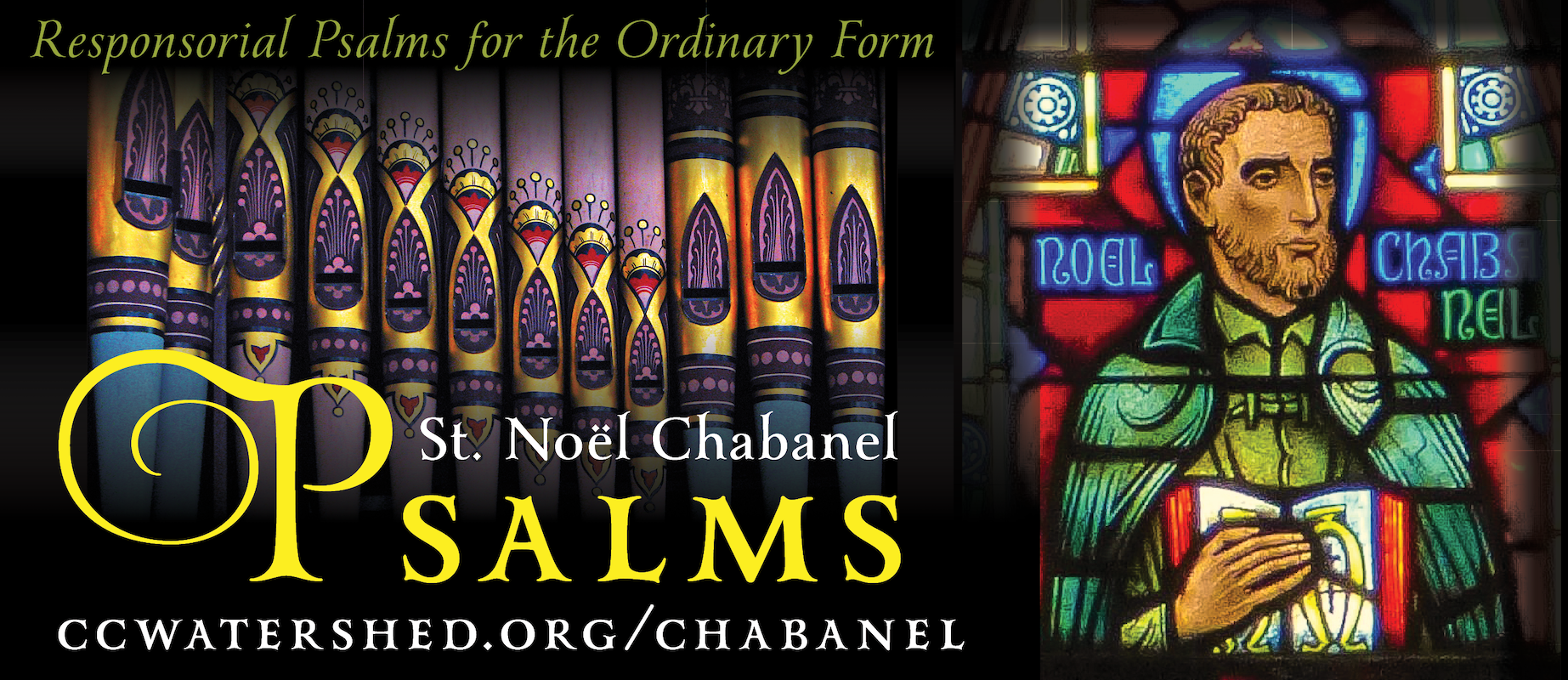Where will you be? …when our website crashes? Why not immediately purchase or download the complete Chabanel Psalms? The settings can be downloaded for free as a convenient PDF file. Learn more.

ORDINARY TIME (Year A) • 02 • 03 • 04 • 05 • 06 • 07 • 08 • 09 • 10 • 11 • 12 • 13 • 14 • 15 • 16 • 17 • 18 • 19 • 20 • 21 • 22 • 23 • 24 • 25 • 26 • 27 • 28 • 29 • 30 • 31 • 32 • 33 • Christ the King
ORDINARY TIME (Year B) • 02 • 03 • 04 • 05 • 06 • 07 • 08 • 09 • 10 • 11 • 12 • 13 • 14 • 15 • 16 • 17 • 18 • 19 • 20 • 21 • 22 • 23 • 24 • 25 • 26 • 27 • 28 • 29 • 30 • 31 • 32 • 33 • Christ the King
ORDINARY TIME (Year C) • 02 • 03 • 04 • 05 • 06 • 07 • 08 • 09 • 10 • 11 • 12 • 13 • 14 • 15 (Option 1) • 15 (Option 2) • 16 • 17 • 18 • 19 • 20 • 21 • 22 • 23 • 24 • 25 • 26 • 27 • 28 • 29 • 30 • 31 • 32 • 33 • Christ the King
ADVENT
(Year A) • 1st • 2nd • 3rd • 4th
(Year B) • 1st • 2nd • 3rd • 4th
(Year C) • 1st • 2nd • 3rd • 4th
CHRISTMAS • Vigil Mass • Midnight Mass • Mass at Dawn • Daytime Mass
Holy Family (ABC) • (Year B “Optional”) • (Year C “Optional”)
Mary, Mother of God (January 1st) • Epiphany of the Lord (ABC)
Baptism of the Lord (ABC) • (Year B “Optional”) • (Year C “Optional”)
LENT & HOLY WEEK • Ash Wednesday
(Year A) 1st • 2nd • 3rd • 4th • 5th
(Year B) 1st • 2nd • 3rd • 4th • 5th
(Year C) 1st • 2nd • 3rd • 4th • 5th
Passion (Palm) Sunday • Holy Thursday • Chrism Mass • Good Friday
HOLY SATURDAY (Easter Vigil) • After 1st Reading (Option 1 Lord, send out your Spirit)
After 1st Reading (Option 2 The earth is full of the goodness of the Lord.)
After 2nd Reading • After 3rd Reading • After 4th Reading • After 5th Reading
After 6th Reading • After 7th Reading (When there is a Baptism)
After 7th Reading (No Baptism / Option 1 You will draw water . . . .)
After 7th Reading (No Baptism / Option 2 Create a clean heart in me, O God.)
Alleluia, Alleluia, Alleluia (Responsorial Psalm Before the Gospel)
EASTERTIDE (1st two Sundays) • Easter Sunday • Divine Mercy Sunday
(Year A) • 03 • 04 • 05 • 06 • 07
(Year B) • 03 • 04 • 05 • 06 • 07
(Year C) • 03 • 04 • 05 • 06 • 07
Ascension of the Lord (ABC) • Vigil of Pentecost (ABC) • Pentecost Sunday (ABC)
Trinity Sunday • (Year A) • (Year B) • (Year C)
Corpus Christi • (Year A) • (Year B) • (Year C)
HOLY DAYS
2 February — Presentation at the Temple (Purification)
19 March — St. Joseph, Spouse of the Blessed Virgin Mary
25 March — Annunciation of the Lord
23 June — (VIGIL) Nativity of St. John the Baptist
24 June — Nativity of St. John the Baptist
28 June — (VIGIL) Saints Peter & Paul
29 June — Saints Peter & Paul
6 August — Transfiguration of the Lord
14 August — (VIGIL) Our Lady’s Assumption
* * 15 August — Our Lady’s Assumption
14 September — Exaltation of the Holy Cross
* * November 1 — All Saints Day
November 2 — All Souls Day
November 9 — Lateran Basilica Dedication
* * 8 December — Immaculate Conception
WEDDING, FUNERAL, & CONFIRMATION (RITUAL MASS)
Funeral Mass (Mass for the Dead) This is Option #1 — Verification
Weddings (Nuptial Mass) This is Option #2 — Verification
Sacrament of Confirmation This is Option #2 — Verification
RANDOM and/or INCOMPLETE and/or BROKEN
All Souls Day — November 2 (Though I walk…)
January 25 — Conversion of Saint Paul
Seasonal Responsorial Psalms
Catholic Funeral Responsorial Psalms
Responsorial Psalms for Catholic Weddings (Nuptial Mass)
Most Sacred Heart of Jesus: Year A • Year B • Year C
ALTERNATE: Sacrament of Confirmation
ADDITIONAL RESOURCES FOR WEDDINGS • Click here
MISCELLANEOUS
* PDF Download • Chabanel Psalm Tones (2014)
“I am more than glad to endorse the Chabanel Psalms and all such worthy efforts to promote authentic liturgical renewal.” — Rev. George W. Rutler (8/15/07)
